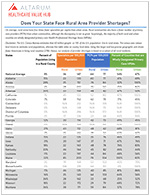Improving Value
Provider Shortages
As the deliverers of healthcare services, doctors, nurses and other providers are the most important resource in our healthcare system. Their absence in communities creates significant (and potentially life-threatening) barriers to care.
It is well-documented that some communities, such as those in rural areas, struggle to recruit and retain qualified medical professionals. Challenges include too high or too low patient volumes, reduced income from treating populations primarily covered by public insurance and a perceived lower quality of life.
The federal and state governments have developed a number of strategies to address the maldistribution of providers across the U.S. At the federal level, the National Health Service Corps,1 a subsidiary of the Health Resources and Services Administration, offers scholarships and loan repayment for primary care professionals—including physicians, dentists, nurse practitioners and physician assistants—to practice in underserved regions. The Corps also grants funding for states to administer their own loan repayment programs.2 Through its J-1 Visa Waiver3/Conrad State 30 program, HRSA allows non-citizen international medical graduates to remain in the U.S. after their training in exchange for service in a designated Health Professional Shortage Area or Medically Underserved Area. Evidence suggests that the program successfully increases providers’ willingness to practice in rural areas in the short-term, although retention rates4 decrease over time.
In addition to operating federally-supported loan repayment programs, states’ efforts to strengthen the rural health workforce, specifically, include investing in recruitment initiatives targeted to middle and high school students and establishing rural residency training programs. The University of Kansas School of Medicine offers admissions preference5 to applicants raised in rural areas (as these students are more likely to return to their hometowns to practice), while other schools have opened campuses6 in small towns to increase the number of local residents that apply.
Additionally, the majority of states have passed legislation to expand non-physician providers’ “scope of practice.” This strategy aims to address shortages of licensed physicians by authorizing other qualified medical professionals, like nurse practitioners and physician assistants, to provide many of the same services. Research shows that,7 in some circumstances, non-physician providers can provide an equally high quality of care as physicians, at a lower cost.
Alternatively, states can use their legislative authority to create entirely new categories of midlevel providers. For example, in 2009, Minnesota became the first state to pass legislation establishing two new categories of mid-level dental providers – dental therapists (DTs) and advanced dental therapists – to deliver educational, clinical and therapeutic services in dental Health Professional Shortage Areas and settings that serve primarily low-income, uninsured and underserved patients. Clinics that have employed DTs have reported increased ability8 to accept new patients, particularly those who are publicly insured, uninsured and/or medically complex. Patients (especially those in rural areas) have reported shorter wait times before getting an appointment and shorter travel distances to receive care.
The use of telehealth is yet another strategy to address shortages of primary and specialty care providers.
Notes
1. National Health Service Corps, "Loan Repayment."
2. National Health Service Corps, "State Loan Repayment Program (SLRP)."
3. Rural Health Information Hub, "Rural J-1 Visa Waiver," (August 14, 2018).
4. National Health Service Corps National Advisory Council, "Retention and the National Health Service Corps," (January 10, 2013).
5. University of Kansas Medical Center, "KU School of Medicine: Scholars in Rural Health," (June 11, 2019).
6. Worth, Tammy, "Osteopathic Med Schools Like Kansas City University Answer The Call For More Doctors," KCUR (February 23, 2017).
7. National Conference of State Legislatures, "Meeting the Primary Care Needs of Rural America: Examining the Role of Non-Physician Providers," (April 2013).
8. Minnesota Department of Health & Minnesota Board of Dentistry, "Early Impacts of Dental Therapists in Minnesota," (February 2014).
- NPR: Creative Recruiting Helps Rural Hospitals Overcome Doctor Shortages (August 15, 2019).







